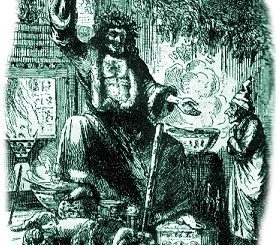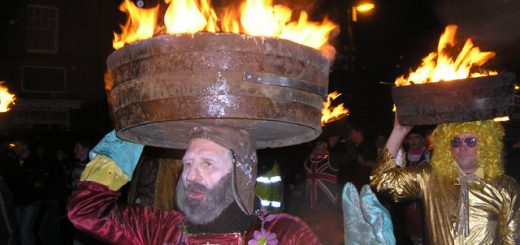Saddleworth Rushcart
Rushbearing dates back to the middle ages and is a festival where rushes were collected to be strewn out over the floors of churches, back when the floors were just earthen. The tradition died off when church floors started to be flagged by the 19th century, though in some villages and towns it was revived as a folk custom. In Saddleworth the church floor was still being covered in rushes up until 1826.
 The Rushcart festival was revived in Saddleworth by the Saddleworth Morris Men in 1975, fifty years after the last Rushcart was built there. Usually 13ft high and weighing 2 tons, the Rushcart is ridden by a ‘Jockey’ (complete with a copper kettle of beer) as it is pulled throughout the villages by roughly 150 Morris Men from around the country who have come to Saddleworth to join the celebration.
The Rushcart festival was revived in Saddleworth by the Saddleworth Morris Men in 1975, fifty years after the last Rushcart was built there. Usually 13ft high and weighing 2 tons, the Rushcart is ridden by a ‘Jockey’ (complete with a copper kettle of beer) as it is pulled throughout the villages by roughly 150 Morris Men from around the country who have come to Saddleworth to join the celebration.
Even though I am from a Saddleworth family I only managed to attend my first Rushcart festival on 25 August 2012 and it was amazing. Morris Men from as far afield as Warwickshire, London and Denmark joined the local Saddleworth dancers who wore black bowlers and red and blue sashes. I caught up with the Rushcart in Delph on the first day of the event. To give you an idea of their itinerary I have included the 2012 timetable below.
Saturday 25th August 2012
9:45am: Uppermill Square
10:45am: Greenfield King Bill
12 noon: Uppermill Museum
2:15pm: Delph Garside Street
4:15pm: Dobcross Square
5:30pm: Dobcross Navigation
Sunday 26th August 2012
10am: Rushcart leaves Uppermill Square
11am: Service at St Chad’s
12 noon to 5:30pm: Fun and games around the Church Inn and Cross Keys including a wrestling competition.
Note: Picture shows a Rushcart in Uppermill, Saddleworth dating from 1880.




Re: Saddleworth Rushcart
WAKES AND RUSH-BEARINGS ON THE LANCASHIRE AND YORKSHIRE BORDER.
The village festival which, in most counties of England, takes place on the anniversary of the day when the parish church was consecrated, or on the day of the saint to whom it is dedicated, is kept here at a different time and in a different manner than in any other county I have lived in. At the approach of autumn, when rushes are in full length, certain days are set apart for the different towns and villages in the neighbourhood of Saddleworth, when all work is stopped, and everybody rejoices and makes merry. Some young men of the parish load a hand-cart with rushes, sometimes ten to twelve feet high and with these carts, which are often most gorgeously decorated with flags, ribbons, etc, sometimes with plate borrowed for the purpose from the wealthier parishioners, and preceded by fife and drum, they march in procession through the parish, stopping at almost every house, and after three hearty cheers for the inhabitants, ask either for a present of money or for some refreshments. The money collected is divided among those who loaded and decorated the rush-cart. This custom of gathering rushes is very old, and dates its origin from times when such luxuries as carpeted pews, with cushions and curtains, hot-water or gas pipes, were not known in our country churches. In those days, at the approach of winter, the young people collected the rushes and took them to the parish church, and covered the floor with them, to keep warm the feet of the good Christians whom the cold winter’s wind, and the long, dreary walk over the snow-covered Yorkshire moors, could not keep from attending matins or evensong. A good old neighbour of mine, seventy-eight years old, well remembers the time when six or eight rush-carts met at Saddleworth Church, and with their contents a warm (church) carpet was prepared for the coming winter. — N. and Q., 2d sen xii. 229.
[Lancashire Legends (1873) by John Harland & T T Wilkinson]